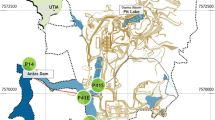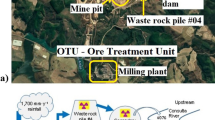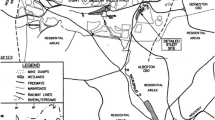Abstract
Uranium mining causes several radiological impacts on the surrounding environment, notably in the water bodies, mainly due to the release of long half-life radionuclides from the 238U and 232Th series. The Ore Treatment Unit, an old uranium mine undergoing decommissioning, has three points of liquid effluent release (#014, #025, and #076). For current study, 78 samples of water were collected at #014, 33 samples at #025, and 63 samples at #076. The radionuclides were analyzed by gross alpha count, gross beta count, and by arsenazo spectrophotometry. Analyses were carried out using the radiological water quality criterion established by World Health Organization and other organizations, together with the Brazilian legislation, to assess if the released effluents may be used unrestrictedly by the individuals of the public. At #014, the mean values of activity concentration (AC), in Bq·L−1, were as follows: Unat = 0.107, 226Ra = 0.035, 210Pb = 0.031, 232Th = 0.007, and 228Ra = 0.049. At #025 the mean values of AC, in Bq·L−1, were as follows: Unat = 0.086, 226Ra = 0.015, 210Pb = 0.028, 232Th = 0.006, and 228Ra = 0.032. Finally, at point #076, the mean AC values, in Bq·L−1, were as follows: Unat = 3.624, 226Ra = 0.074, 210Pb = 0.054, 232Th = 0.013, and 228Ra = 0.069. The current study showed that natural radionuclides were not in secular equilibrium. Despite uranium presented its values outside the limits of guidance levels, it can be state that the unrestricted use of effluents released in the three water bodies is authorized from the radiological point of view. In terms of dose rate, the releases at three points were within the radiological limits of potability. On the other hand, in an additional analysis, #76 presented chemical toxicity above the authorized value, pointing the need of restricted use of water from the point of view of chemical toxicity.






Similar content being viewed by others
Data availability
The datasets analyzed during the current study are not publicly available because it becomes unfeasible to make available a very large set of data in a published article. However, the data are accessible through reasonable request to the corresponding author.
References
Addisie MB (2022) Evaluating drinking water quality using water quality parameters and esthetic attributes. Air Soil Water Res 15:11786221221075004
Adeola AO, Iwuozor KO, Akpomie KG, Adegoke KA, Oyedotun KO, Ighalo JO et al (2022) Advances in the management of radioactive wastes and radionuclide contamination in environmental compartments: a review. Environ Geochem Health 1–27. https://doi.org/10.1007/s10653-022-01378-7
Alwan NT, Shcheklein SE, Ali OM (2021) Evaluation of distilled water quality and production costs from a modified solar still integrated with an outdoor solar water heater. Case Stud Therm Eng 27:101216
Au WW, Lane RG, Legator MS, Whorton EB, Wilkinson GS, Gabehart GJ (1995) Biomarker monitoring of a population residing near uranium mining activities. Environ Health Perspect 103(5):466–470
Baeza A, Salas A, Guillén J, Muñoz-Serrano A, Ontalba-Salamanca MÁ, Jiménez-Ramos MC (2017) Removal naturally occurring radionuclides from drinking water using a filter specifically designed for Drinking Water Treatment Plants. Chemosphere 167:107–113
Banala UK, Das NPI, Padhi RK, Toleti SR (2021) Alkaliphilic bacteria retrieved from uranium mining effluent: characterization, U sequestration and remediation potential. Environ Technol Innov 24:101893
Brasil, Ministério da Saúde (2011) Procedimentos de controle e de vigilância da qualidade da água para consumo humano e seu padrão de potabilidade. Portaria No. 2.914, de 12 de Dezembro de 2011. 34p. Brasilia: Ministério da Saúde. https://bvsms.saude.gov.br/bvs/saudelegis/gm/2011/prt2914_12_12_2011.html
Brasil, Ministério da Saúde (2017) Portaria Consolidação nº 5 de 28 de setembro de 2017. Brasília: Brasil.Ministério da Saúde, Governo Federal. Brasilia: DOU. https://portalarquivos2.saude.gov.br/images/pdf/2018/marco/29/PRC-5-Portaria-de-Consolida----o-n---5--de-28-de-setembro-de-2017.pdf
Brasil, Ministério da Saúde (2021) PORTARIA GM/MS Nº 888, DE 4 DE MAIO DE 2021. Brasília: Brasil. Ministério da Saúde, Governo Federal. Brasilia: DOU. https://www.in.gov.br/en/web/dou/-/portaria-gm/ms-n-888-de-4-de-maio-de-2021-318461562
Brasil CONAMA (1986) Resolution nº 1, January 23th 1986. Published in DOU, February 17th. Brasilia: DOU. http://www2.mma.gov.br/port/conama/legiabre.cfm?codlegi=23
Brasil CONAMA (2005) Resolution Nº 357, March 17th, 2005. Published in DOU nº 053, de 18/03/2005. DOU, Brasília, pp. 58 – 63. . Brasília: DOU. http://www2.mma.gov.br/port/conama/legiabre.cfm?codlegi=459
Carvalho FP, Oliveira JM (2007) Alpha emitters from uranium mining in the environment. J Radioanal Nucl Chem 274:167–174
Carvalho FP, Madruga MJ, Reis MC, Alves JG, Oliveira JM, Silva L (2007) Radioactivity in the environment around past radium and uranium mining sites of Portugal. J Environ Radioact 96:39–46
Carvalho FP, Oliveira JM, Lopes I, Batista A (2007) Radionuclides from past uranium mining in Rivers of Portugal. J Environ Radioact 98:298–314
Chen J, Cooke MW, Mercier JF (2018) A review of natural radionuclides in Canadian drinking water (1975–16). Radiat Prot Dosimetry 179(1):26–36
Cipriani M (2002) Mitigation of social and environmental impacts due to definitive closure of uranium mines. Doctoral thesis. Campinas State University (in Portuguese)
CNEN (1991) Ofício CNEN – SNU n° 901/91 de 22/07/1991
CNEN (1997) Derived limits for the liquid effluent release points of the Poços de Caldas Industrial Complex of the Ore Treatment Unit of the Nuclear Industries of Brazil. Rio de Janeiro, letter n° 050/SLC (in Portuguese)
CNEN (2011) Posição regulatória 3.01/008:2011, programa de monitoração radiológica ambiental. Rio de Janeiro: CNEN.
CNEN (2014) Norm CNEN-NN-3.01, Basic Guidelines for Radiological Protection. Rio de Janeiro: CNEN.
CNEN (2020) Posição regulatória 3.01/012:2020, Níveis de investigação e de referência para radioatividade em água potável: CNEN
Dinis MDL, Fiúza A (2021) Mitigation of uranium mining impacts—a review on groundwater remediation technologies. Geosciences 11(6):250
El Mountassir O, Bahir M, Chehbouni A, Dhiba D, El Jiar H (2022) Assessment of groundwater quality and the main controls on its hydrochemistry in a changing climate in Morocco (Essaouira Basin). Sustainability 14(13):8012
EURATOM (2013) No. 2013/51 laying down requirements for the protection of the health of the general public with regard to radioactive substances in water intended for human consumption (2013). Geneve: EURATOM
Ferrari CR, Nascimento HA, Rodgher S, Almeida T, Brushi AL, Nascimento MR, Bonifácio RL (2017) Effects of the discharge of uranium mining effluents on the water quality of the reservoir: an integrative chemical and ecotoxicological assessment. Sci Report. https://doi.org/10.1038/s41598-017-14100-w
Fleming C, Belmer N, Reynolds JK, Robba L, Davies PJ, Wright IA (2022) Legacy contamination of river sediments from four decades of coal mine effluent inhibits ecological recovery of a polluted world heritage area river. Water Air Soil Pollut 233(1):15
Fu M, Ao J, Ma L, Kong D, Qi S, Zhang P et al (2022) Uranium removal from waste water of the tailings with functional recycled plastic membrane. Sep Purif Technol 287:120572
Godoy JM, Lauria DC, Godoy ML, Cunha R (1994) Development of a sequential method for determination of 238U, 234U, 232Th, 230Th, 228Th, 228Ra, 226Ra and 210Pb in environmental samples. J Radioanal Nucl Chem 182:165–169
Guerrero JL, Suárez-Vaz N, Paz-Gómez DC, Pérez-Moreno SM, Bolívar JP (2023) Spatiotemporal evolution of U and Th isotopes in a mine effluent highly polluted by Acid Mine Drainage (AMD). J Hazard Mater 130782
Guo K, Cheng C, Chen L, Xie J, Li S, He S, Xiao F (2022) Application of Deinococcus radiodurans in the treatment of environmental pollution by heavy metals and radionuclides. J Radioanal Nucl Chem 331(2):655–664
Haribala HB, Wang C, Gerilemandahu XX, Zhang S, Bao S, Li Y (2016) Assessment of radioactive materials and heavy metals in the surface soil around uranium mining area of Tongliao, China. Ecotoxicol Environ Saf 130:185–192
IAEA (2002) Dispersion of radioactive material in air and water and consideration of population distribution in site evaluation for nuclear power plants. IAEA, Vienna
IAEA (2004) Occupational radiation protection in the mining and processing of raw materials safety guide. IAEA, Vienna
IAEA (2005) Environmental and source monitoring for purposes of radiation protection safety guide. IAEA, Vienna
IAEA (2013) Management of NORM Residues. IAEA, Vienna
IAEA (2016) Criteria for radionuclide activity concentrations for food and drinking water, IAEA-TECDO-1788. IAEA, Vienna
IAEA (2018) Regulatory control of radioactive discharges to the environment. IAEA, Vienna
IAEA (2018) Prospective radiological environmental impact assessment for facilities and activities. IAEA, Vienna
IAEA (2002a) Management of radioactive waste from the mining and milling of ores, WS-G-1.2. Vienna: IAEA
IAEA (2004a) Protection in the mining and processing of raw materials, safety standard series, no RS-G-1.6. Vienna: IAEA
IAEA (2011) Criteria for use in preparedness and response for a nuclear or radiological emergency. IAEA Safety Standards Series No. GSR-2. IAEA. Vienna: IAEA
IAEA (2012) Monitoring for compliance with remediation criteria for sites, safety reports series No. 72. Vienna: IAEA
IAEA (2014a) Monitoring and surveillance of radioactive waste disposal facilities Specific Safety Guide No. SSG-31, ISBN 978–92 –0–115513–9; ISSN 1020–525X, 73 PP. Vienna: IAEA
IAEA (2014b) Radiation protection and safety of radiation sources: International Basic Safety Standards. IAEA Safety Standards Series No. GSR Part 3. Vienna: IAEA
IAEA (2015) Preparedness and response for a nuclear or radiological emergency. IAEA, Safety Standards Series No. GSR Part7. IAEA, Vienna. Vienna: IAEA
IAEA (2018a) Radiation protection of the public and the environment, General Safety Guide, Safety Standards Series No. GSG-8. Vienna: IAEA
ICRP (2007) Recommendations of the International Commission on Radiological Protection, no 103. Elsevier, New York
ICRP (2006). Assessing dose of the representative person for the purpose of the radiation protection of the public. ICRP Publication 101a. Ann. ICRP 36 (3). New York: Elsevier.
Jamshidi A, Morovati M, GolbiniMofrad MM, Panahandeh M, Soleimani H, AbdolahpourAlamdari H (2021) Water quality evaluation and non-cariogenic risk assessment of exposure to nitrate in groundwater resources of Kamyaran, Iran: spatial distribution, Monte-Carlo simulation, and sensitivity analysis. J Environ Health Sci Eng 19(1):1117–1131
Ko SH, Sakai H (2021) Evaluation of Yangon city tap water quality and the efficacy of household treatment. Water Qual Res J 56(3):155–166
Kutsevol N, Kuziv Y, Cabrera T, Husson SM, DeVol TA, Bliznyuk V (2021) Biodegradable star-like polymer flocculants for rapid, efficient purification of water contaminated with industrial radionuclides. Sep Purif Technol 273:118630
La Verde G, Artiola V, D’Avino V, La Commara M, Panico M, Polichetti S, Pugliese M (2021) Measurement of natural radionuclides in drinking water and risk assessment in a volcanic region of Italy. Campania Water 13(22):3271
Lei F, Zhang W, Zhou Y, Zhou N, Liu T, Shi K et al (2022) Efficient removal of uranium from wastewater using amidoxime-carboxyl functional resin with large particle size. J Radioanal Nucl Chem 1–13
Li S, Zhu Q, Luo J, Shu Y, Guo K, Xie J et al (2021) Application progress of deinococcus radiodurans in biological treatment of radioactive uranium-containing wastewater. Indian J Microbiol 61(4):417–426
Miller KD, Bentley MJ, Ryan JN, Linden KG, Larison C, Kienzle BA et al (2021) Mine water use, treatment, and reuse in the United States: a look at current industry practices and select case studies. ACS ES&T Eng 2(3):391–408
Minitab (2007) Minitab Statistical Software, Release 15 for Windows. Pennsylvania: State College
Mkandawire M, Dudel EG (2005) Accumulation of arsenic in Lemnagibba L. (duckweed) in tailing waters of two abandoned uranium mining sites in Saxony, Germany. Sci Total Environ 336:81–89
Momcilovic M, Kovacevics J, Dragovic S (2010) Population doses from terrestrial exposure in the vicinity of abandoned uranium mines in Serbia. Radiat Meas 45:225–230
Nezhad MM, Semnani A, Tavakkoli N, Shirani M (2021) Selective and highly efficient removal of uranium from radioactive effluents by activated carbon functionalized with 2-aminobenzoic acid as a new sorbent. J Environ Manage 299:113587
NRC (2000) Radionuclides Rule 66 FR 76708, vol. 65 NRC, Washingthon No. 236. Wasington: NRC
Oyedele JA, Shimboyo S, Sitoka S, Gaoseb F (2010) Assessment of natural radioactivity in the soils of Rossing Uranium Mine and its satellite town in western Namibia, southern Africa. Nucl Instr Meth Phys Res a 619:467–469
Pan M, Cui C, Tang W, Guo Z, Zhang D, Xu X, Li J (2022) Carbon cloth as an important electrode support for the high selective electrosorption of uranium from acidic uranium mine wastewater. Sep Purif Technol 281:119843
Pereira WS, Kelecom A, Pereira JR, PyJúnior D (2013) Release of uranium by an ore treatment unit at Caldas, MG, Brazil. J Environ Protect. https://doi.org/10.4236/jep.2013.46066
Pereira WS, Kelecom A, Pereira JRS (2014) Analysis of radium isotopes in surface waters nearby a phosphate mining with NORM at Santa Quitéria, Brazil. J Environ Protect (online) 05:193–199
Pereira WS, Kelecom A, Silva AX, Carmo AS, PyJúnior DA (2018) Assessment of uranium release to the environment from a disabled uranium mine in Brazil. J Environm Radioact 188:18–22
Pereira W, Kelecom A, Lopes JM, do Carmo AS, Júnior DDAP, Silva AX (2020) Evaluation of the radiological quality of water released by a uranium mining in Brazil. Environ Sci Pollut Res 27(29):36704–36717
Pereira WS, Kelecom A, Lopes JM et al (2021) Radiological quality of wastewater released from a waste dam containing natural radionuclides. J Radioanal Nucl Chem 1–15. https://doi.org/10.1007/s10967-021-07973-9
Pereira WS, Kelecom A, Charles-Pierre M et al (2022) Assessment of released natural radionuclides by waste rock pile and mining pit associated with a uranium mine at Caldas, Minas Gerais, Brazil. Environ Sci Pollut Res 29(38):58065–58077
Pereira WS, Lopes JM, Kelecom A, Garcêz RWD, Silva AX, Dam RSF, Paiva AKS (2021a) Lifetime cancer risk increase due to consumption of some foods from a High Background Radiation Area. Appl Radiat Isot 176
Pereira WS (2010) The calculation of absorbed dose as a tool for environmental radioprotection. Doctoral thesis. Fluminense Federal University (in Portuguese)
Pervez S, Dugga P, Siddiqui MN, Bano S, Verma M, Candeias C et al (2021) Sources and health risk assessment of potentially toxic elements in groundwater in the mineral-rich tribal belt of Bastar, Central India. Groundw Sustain Dev 14:100628
Queiroz MT, Sabará MG, Queiroz CA, Leão MM, Amorim CC, Lima LR (2016) Estudo sobre os teores de Tório, Urânio e Potássio nas águas superficiais e sedimento marginal do Rio Piracicaba, Minas Gerais, Brasil. Eng Sanit Ambient. https://doi.org/10.1590/s1413-41522016126287
Ragheb E, Shamsipur M, Jalali F, Mousavi F (2022) Modified magnetic-metal organic framework as a green and efficient adsorbent for removal of heavy metals. J Environ Chem Eng 10(2):107297
Rashid M, Khan MN, Jalbani N (2021) Detection of human adenovirus, Rotavirus, and Enterovirus in tap water and their association with the overall quality of water in Karachi, Pakistan. Food Environ Virol 13(1):44–52
Rodgher S, Azevedo H, Ferrari CR, Roque CV, Ronqui LB, Campos MB, Nascimento MR (2013) Evaluation of surface water quality in aquatic bodies under the influence of uranium mining (MG, Brazil). Environ Monit Assess 185:2395–2406
Rosner B (2016) Fundamentals of biostatistic. Duxbury Thonson Learning, Stanford
Savvin SB (1961) Analytical use of arsenazo III: determination of thorium, zirconium, uranium and rare earth elements. Talanta 8:673–685
Savvin SB (1964) Analytical applications of arsenazo III—II: determination of thorium, uranium, protactinium, neptunium, hafnium and scandium. Talanta 11:1–6
Schork MA, Remington RD (2000) Statistic with applications to the biological and Health science. Prentice: Upper Saddle River
Silva LB, Lopes JM, Pereira WS, Garcêz RWD, Silva AX, Talhofer JL (2021) Committed effective dose and lifetime cancer risk due to ingestion of natural radionuclides in grains grown in an area of high background radiation. Appl Radiat Isot 172:109656. https://doi.org/10.1016/j.apradiso.2021.109656
Silva LB (2020) Committed effective dose and estimated incidence of cancer due to ingestion of 40K, 226Ra, 228Ra and 228Th in grains from Poços de Caldas City. M.Sc. Masters Dissertation. Federal University of Rio de Janeiro. 86 pp. (in Portuguese)
Slavchev B, Tonev D, Dobrev L, Geleva E, Veleva B, Protohristov H et al (2022) Uranium and 210Po radionuclides in drinking water in southern Bulgaria and expected radiation doses. Radiat Prot Dosimetry 198(5):299–309
Srinivas D, Ramesh VB, Patra I, Tripathi S, Ramayya MS, Chaturvedi AK (2017) Assessment of background gamma radiation levels using airborne gamma ray spectrometer data over uranium deposits, Cuddapah Basin, India - a comparative study of dose rates estimated by AGRS and PGRS. J Environ Radioact 167:1–12
Srivastava RR, Pathak P, Perween M (2020) Environmental and health impact due to uranium mining. In: Gupta, D., Walther, C. (eds) Uranium in Plants and the Environment. Radionuclides and Heavy Metals in the Environment. Springer, Cham. https://doi.org/10.1007/978-3-030-14961-1_3
Szabo Z, Stackelberg PE, Cravotta CA III (2020) Occurrence and geochemistry of lead-210 and polonium-210 radionuclides in public-drinking-water supplies from principal aquifers of the United States. Environ Sci Technol 54(12):7236–7249
Tripathi RM, Sahoo SK, Jha VN, Khan AH, Puranik VD (2008) Assessment of environmental radioactivity at uranium mining, processing and tailings management facility at Jaduguda, India. Appl Radiat Isot 66:1666–1670
USEPA (1997) Exposure Factors Handbook, v. 1, 2, and 3. Washington, D.C. Washington: USEPA
USEPA (2000) National primary drinking water regulations; radionuclides; final rule. Part II. 40 CFR Parts 9, 141, and 142. Washington DC: USEPA. Whashington: USEPA
Vieira S (2006) Análise de Variância (ANOVA). Atlas, Rio de Janeiro
WHO0. (2006) World Health Organization. Guidelines for Drinking-water Quality: Incorporating First Addendum. Geneva
WHO (2011) World Health Organization. Guidelines for drinking-water quality. 4th Ed.,WHO, Geneva
WHO (2017) World Health Organization. Guidelines for drinking-water quality: fourth edition incorporating the first addendum. Switzerland
WHO (2018) World Health Organization. Management of radioactivity in drinking-water. Genève
Zhang X, Liu Y (2020) Nanomaterials for radioactive wastewater decontamination. Environ Sci Nano 7(4):1008–1040
Author information
Authors and Affiliations
Contributions
WSP: conceptualization, data curation, formal analysis, methodology, writing—original draft. AK: conceptualization, supervision, writing—review and editing. JML: conceptualization, data curation, investigation, writing—review and editing. MCP: data curation, writing—review and editing. ELCC: conceptualization, writing—review and editing. ASC: writing—review and editing. LGPF: writing—review and editing. AKSP: writing—review and editing. AXS: project administration, resources, supervision.
Corresponding author
Ethics declarations
Ethics approval and consent to participate
Not applicable.
Consent for publication
Not applicable.
Competing interests
The authors declare no competing interests.
Additional information
Responsible Editor: Georg Steinhauser
Publisher's note
Springer Nature remains neutral with regard to jurisdictional claims in published maps and institutional affiliations.
Rights and permissions
Springer Nature or its licensor (e.g. a society or other partner) holds exclusive rights to this article under a publishing agreement with the author(s) or other rightsholder(s); author self-archiving of the accepted manuscript version of this article is solely governed by the terms of such publishing agreement and applicable law.
About this article
Cite this article
Pereira, W.S., Kelecom, A., Lopes, J.M. et al. Application of radiological assessment as water quality criterion for effluent release in a Brazilian uranium mine. Environ Sci Pollut Res 30, 65379–65391 (2023). https://doi.org/10.1007/s11356-023-26964-9
Received:
Accepted:
Published:
Issue Date:
DOI: https://doi.org/10.1007/s11356-023-26964-9




